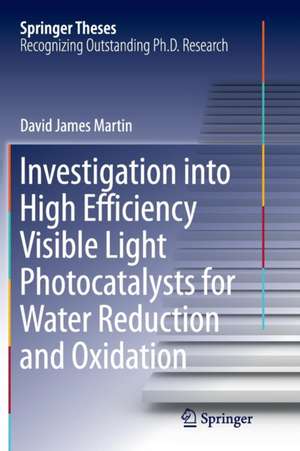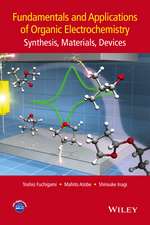Investigation into High Efficiency Visible Light Photocatalysts for Water Reduction and Oxidation: Springer Theses
Autor David James Martinen Limba Engleză Paperback – 9 oct 2016
Photocatalytic water splitting using solar irradiation can potentially offer a zero-carbon renewable energy source, yielding hydrogen and oxygen as clean products. These two ‘solar’ products can be used directly in fuel cells or combustion to provide clean electricity or other energy. Alternatively they can be utilised as separate entities for feedstock-based reactions, and are considered to be the two cornerstones of hydrogenation and oxidation reactions, including the production of methanol as a safe/portable fuel, or conventional catalytic reactions such as Fischer-Tropsch synthesis and ethylene oxide production.
The main driving force behind the investigation is the fact that no photocatalyst system has yet reported combined high efficiency, high stability, and cost effectiveness; though cheap and stable, most suffer from low efficiency.
| Toate formatele și edițiile | Preț | Express |
|---|---|---|
| Paperback (1) | 634.68 lei 6-8 săpt. | |
| Springer International Publishing – 9 oct 2016 | 634.68 lei 6-8 săpt. | |
| Hardback (1) | 640.88 lei 6-8 săpt. | |
| Springer International Publishing – 29 mai 2015 | 640.88 lei 6-8 săpt. |
Din seria Springer Theses
- 5%
 Preț: 1154.07 lei
Preț: 1154.07 lei -
 Preț: 389.88 lei
Preț: 389.88 lei - 15%
 Preț: 646.94 lei
Preț: 646.94 lei - 18%
 Preț: 1220.45 lei
Preț: 1220.45 lei -
 Preț: 399.29 lei
Preț: 399.29 lei - 18%
 Preț: 997.88 lei
Preț: 997.88 lei - 18%
 Preț: 941.05 lei
Preț: 941.05 lei -
 Preț: 544.53 lei
Preț: 544.53 lei - 15%
 Preț: 643.16 lei
Preț: 643.16 lei - 15%
 Preț: 642.68 lei
Preț: 642.68 lei - 15%
 Preț: 639.25 lei
Preț: 639.25 lei - 20%
 Preț: 558.82 lei
Preț: 558.82 lei - 18%
 Preț: 943.43 lei
Preț: 943.43 lei - 18%
 Preț: 1116.26 lei
Preț: 1116.26 lei - 15%
 Preț: 640.06 lei
Preț: 640.06 lei - 15%
 Preț: 640.06 lei
Preț: 640.06 lei -
 Preț: 276.68 lei
Preț: 276.68 lei - 15%
 Preț: 636.45 lei
Preț: 636.45 lei - 18%
 Preț: 891.17 lei
Preț: 891.17 lei - 15%
 Preț: 640.88 lei
Preț: 640.88 lei -
 Preț: 389.70 lei
Preț: 389.70 lei - 20%
 Preț: 563.89 lei
Preț: 563.89 lei -
 Preț: 393.35 lei
Preț: 393.35 lei - 15%
 Preț: 637.93 lei
Preț: 637.93 lei - 15%
 Preț: 641.85 lei
Preț: 641.85 lei - 18%
 Preț: 1112.30 lei
Preț: 1112.30 lei - 20%
 Preț: 551.36 lei
Preț: 551.36 lei - 18%
 Preț: 1103.62 lei
Preț: 1103.62 lei - 18%
 Preț: 1109.92 lei
Preț: 1109.92 lei - 18%
 Preț: 1225.94 lei
Preț: 1225.94 lei - 18%
 Preț: 944.99 lei
Preț: 944.99 lei - 18%
 Preț: 944.19 lei
Preț: 944.19 lei - 15%
 Preț: 640.06 lei
Preț: 640.06 lei - 18%
 Preț: 1229.10 lei
Preț: 1229.10 lei - 15%
 Preț: 640.06 lei
Preț: 640.06 lei - 18%
 Preț: 1217.27 lei
Preț: 1217.27 lei - 15%
 Preț: 636.80 lei
Preț: 636.80 lei - 18%
 Preț: 1000.87 lei
Preț: 1000.87 lei - 15%
 Preț: 635.96 lei
Preț: 635.96 lei - 15%
 Preț: 640.88 lei
Preț: 640.88 lei -
 Preț: 387.20 lei
Preț: 387.20 lei - 18%
 Preț: 999.45 lei
Preț: 999.45 lei -
 Preț: 385.25 lei
Preț: 385.25 lei -
 Preț: 385.25 lei
Preț: 385.25 lei - 18%
 Preț: 1109.92 lei
Preț: 1109.92 lei - 18%
 Preț: 1110.72 lei
Preț: 1110.72 lei -
 Preț: 386.99 lei
Preț: 386.99 lei - 15%
 Preț: 637.13 lei
Preț: 637.13 lei - 20%
 Preț: 554.20 lei
Preț: 554.20 lei - 20%
 Preț: 555.57 lei
Preț: 555.57 lei
Preț: 634.68 lei
Preț vechi: 746.69 lei
-15% Nou
Puncte Express: 952
Preț estimativ în valută:
121.46€ • 125.31$ • 102.80£
121.46€ • 125.31$ • 102.80£
Carte tipărită la comandă
Livrare economică 04-18 martie
Preluare comenzi: 021 569.72.76
Specificații
ISBN-13: 9783319369501
ISBN-10: 3319369504
Pagini: 177
Ilustrații: XXVIII, 149 p. 76 illus., 62 illus. in color.
Dimensiuni: 155 x 235 x 10 mm
Greutate: 0.26 kg
Ediția:Softcover reprint of the original 1st ed. 2015
Editura: Springer International Publishing
Colecția Springer
Seria Springer Theses
Locul publicării:Cham, Switzerland
ISBN-10: 3319369504
Pagini: 177
Ilustrații: XXVIII, 149 p. 76 illus., 62 illus. in color.
Dimensiuni: 155 x 235 x 10 mm
Greutate: 0.26 kg
Ediția:Softcover reprint of the original 1st ed. 2015
Editura: Springer International Publishing
Colecția Springer
Seria Springer Theses
Locul publicării:Cham, Switzerland
Cuprins
Introduction: Fundamentals of Water Splitting and Literature Survey.- Experimental Development.- Oxygen Evolving Photocatalyst Development.- Hydrogen Evolving Photocatalyst Development.- Novel Z-Scheme Overall Water Splitting Systems.- Overall Conclusions and Future Work.
Notă biografică
Dr. David James Martin studied Physics at the University of Liverpool (MPhys), and then completed a PhD in Chemical Engineering at University College London (UCL) under the tutelage of Dr. Junwang Tang. His thesis focused on the oxidation, reduction, and overall splitting of water using visible light photocatalysts. David is currently a UCL Chemistry research associate working with Dr. Andrew Beale. David’s present research focuses on X-ray diffraction and scattering techniques for in situ characterisation of heterogeneous catalysts. David has a comprehensive and complementary background in photocatalysis for water splitting and heterogeneous catalysis with expertise focused on in situ/operando methods for materials characterisation.
Textul de pe ultima copertă
This thesis describes novel strategies for the rational design of several cutting-edge high-efficiency photocatalysts, for applications such as water photooxidation, reduction, and overall splitting using a Z-Scheme system. As such, it focuses on efficient strategies for reducing energy loss by controlling charge transfer and separation, including novel faceted forms of silver phosphate for water photooxidation at record high rates, surface-basic highly polymerised graphitic carbon nitride for extremely efficient hydrogen production, and the first example of overall water splitting using a graphitic carbon nitride-based Z-Scheme system.
Photocatalytic water splitting using solar irradiation can potentially offer a zero-carbon renewable energy source, yielding hydrogen and oxygen as clean products. These two ‘solar’ products can be used directly in fuel cells or combustion to provide clean electricity or other energy. Alternatively they can be utilised as separate entities for feedstock-based reactions, and are considered to be the two cornerstones of hydrogenation and oxidation reactions, including the production of methanol as a safe/portable fuel, or conventional catalytic reactions such as Fischer-Tropsch synthesis and ethylene oxide production.
The main driving force behind the investigation is the fact that no photocatalyst system has yet reported combined high efficiency, high stability, and cost effectiveness; though cheap and stable, most suffer from low efficiency.
Photocatalytic water splitting using solar irradiation can potentially offer a zero-carbon renewable energy source, yielding hydrogen and oxygen as clean products. These two ‘solar’ products can be used directly in fuel cells or combustion to provide clean electricity or other energy. Alternatively they can be utilised as separate entities for feedstock-based reactions, and are considered to be the two cornerstones of hydrogenation and oxidation reactions, including the production of methanol as a safe/portable fuel, or conventional catalytic reactions such as Fischer-Tropsch synthesis and ethylene oxide production.
The main driving force behind the investigation is the fact that no photocatalyst system has yet reported combined high efficiency, high stability, and cost effectiveness; though cheap and stable, most suffer from low efficiency.
Caracteristici
Nominated as an outstanding PhD thesis by the University College London, UK Demonstrates a novel strategy for designing efficient photocatalysts for renewable fuel synthesis on the basis of solar irradiation Includes a survey of available literature, along with in-depth synthesis methods, characterisation and analysis of several new photocatalysts Includes supplementary material: sn.pub/extras










